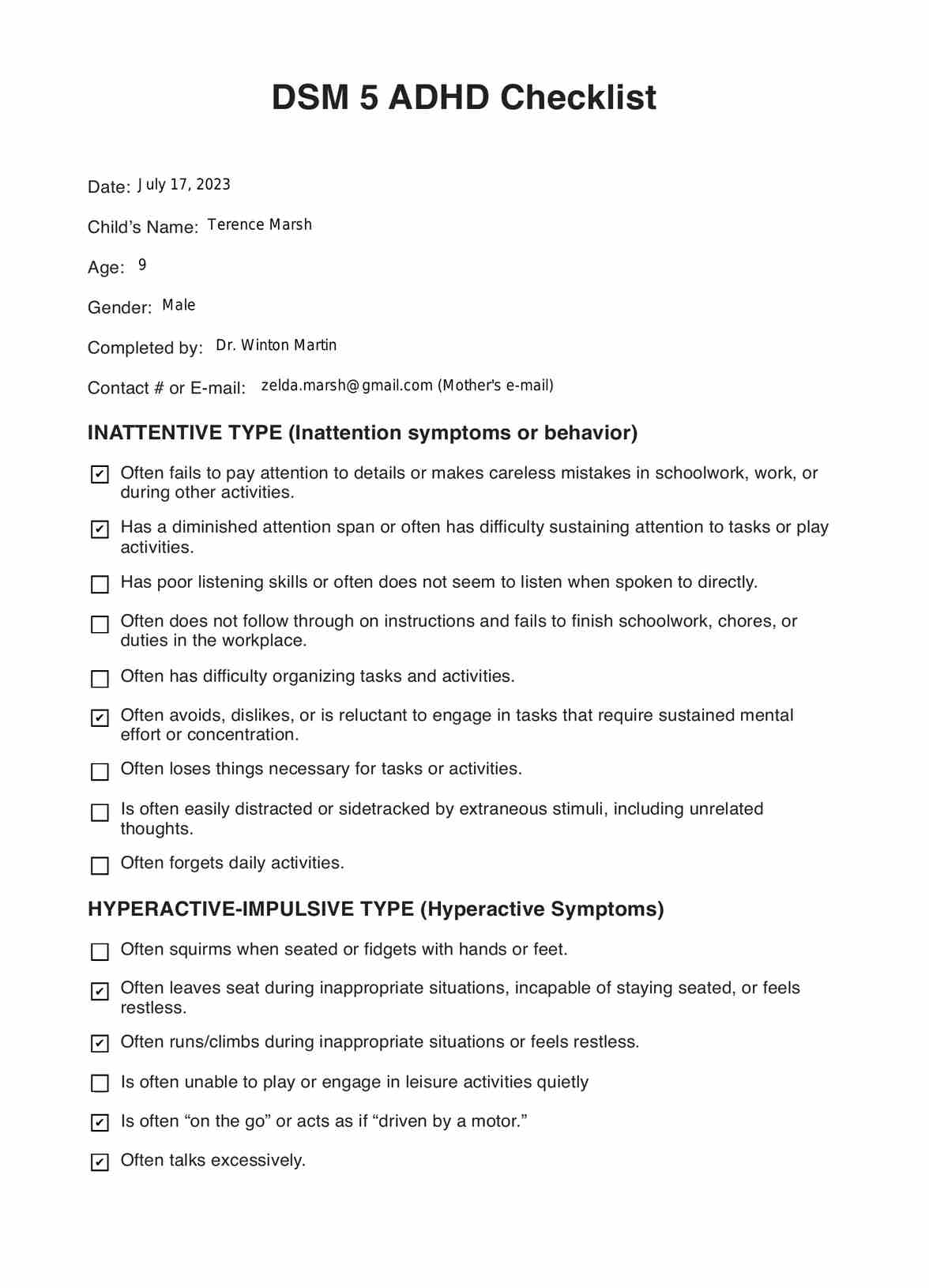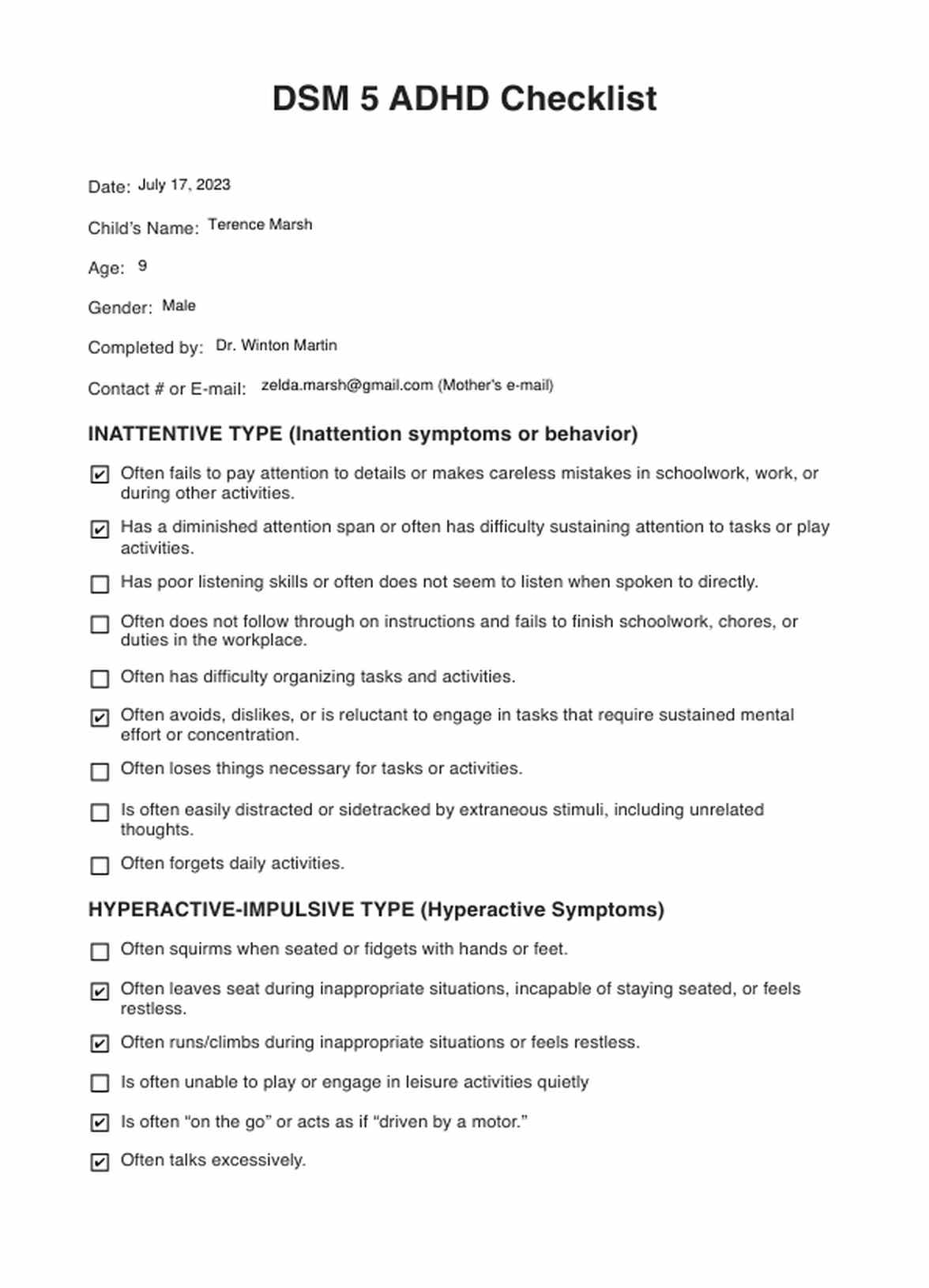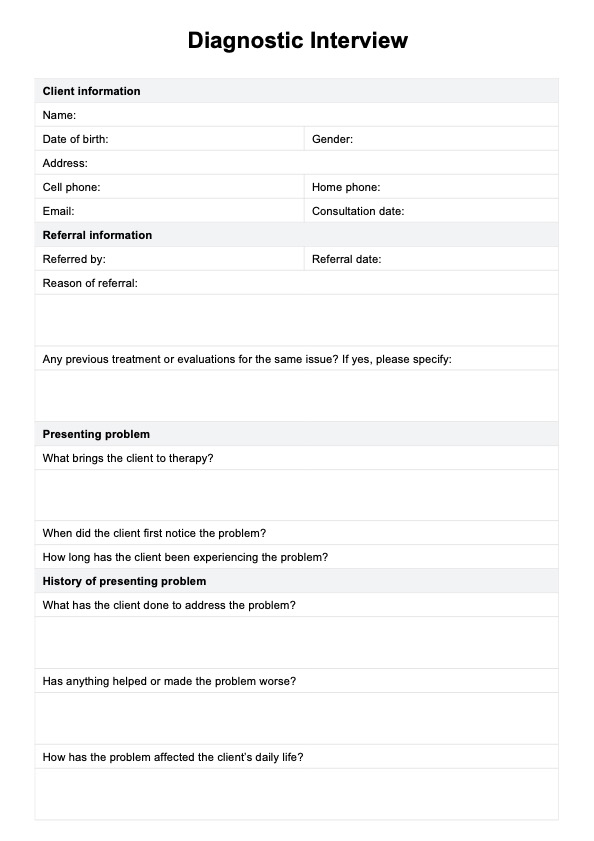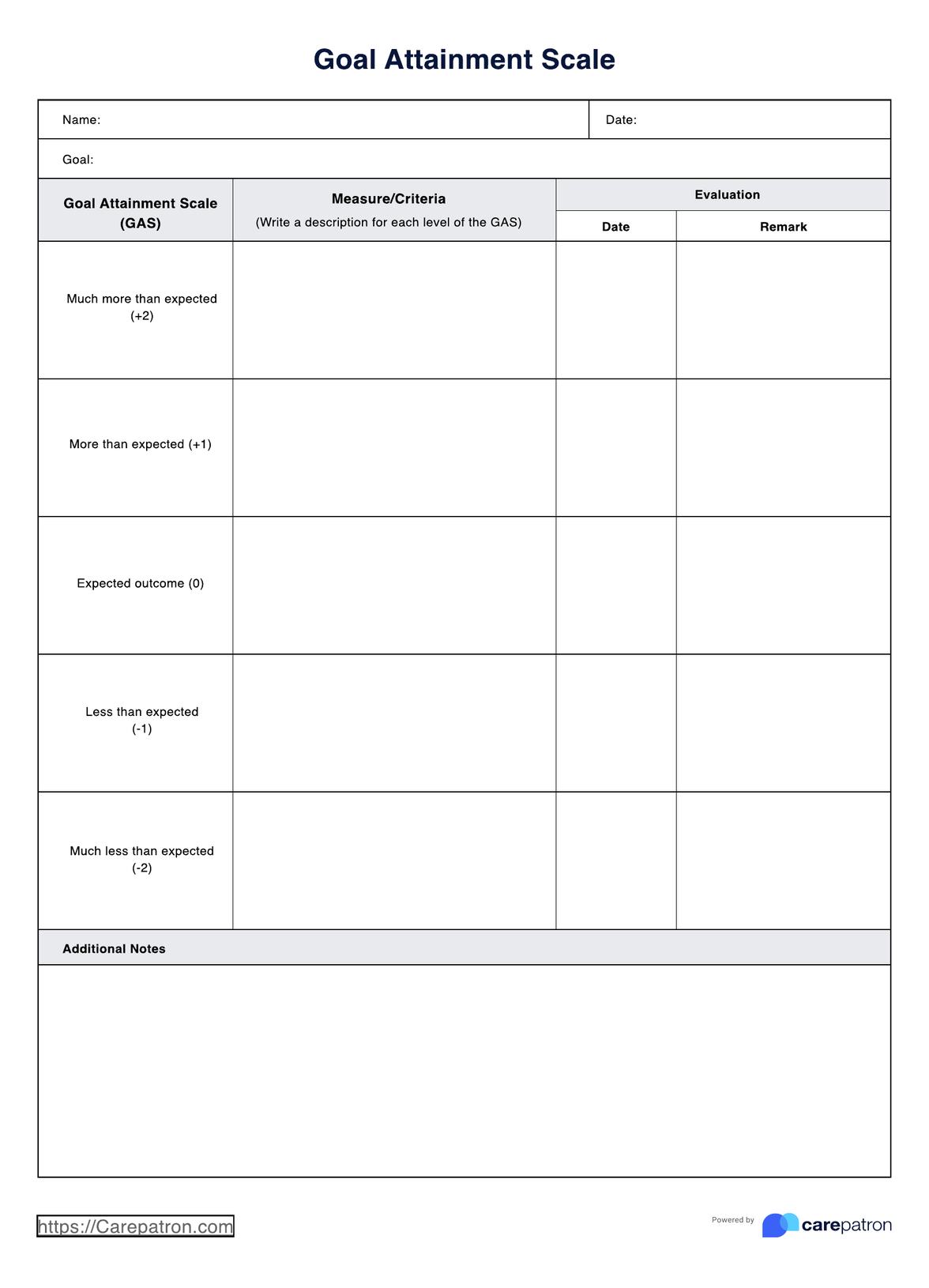DSM 5 ADHD Checklist
Check if your patient has ADHD with the help of this DSM-5 ADHD checklist. Click here for a copy of our template and more information on the document.


What is the DSM-5 checklist for ADHD
The DSM-5, which stands for the Diagnostic and Statistical Manual of Mental Disorders, Fifth Edition, published by the American Psychiatric Association, provides standardized criteria to diagnose ADHD (Attention-Deficit/Hyperactivity Disorder). ADHD is characterized by patterns of inattention, hyperactivity, and impulsivity that interfere with functioning or development. The DSM-5 checklist for ADHD includes several key criteria:
Symptoms
Multiple symptoms of inattention and/or hyperactivity-impulsivity have been present for at least six months.
- Inattention: This includes six or more symptoms of inattention for children up to age 16 or five or more for adolescents 17 and older and adults. Symptoms of inattention include difficulty sustaining attention, failure to give close attention to details or careless mistakes in schoolwork, work, or other activities, difficulty organizing tasks and activities, and being easily distracted by unrelated stimuli.
- Hyperactivity and impulsivity: This includes six or more symptoms of hyperactivity-impulsivity for children up to age 16 or five or more for adolescents 17 and older and adults. Hyperactive symptoms might include fidgeting tapping, or running about in situations where it is inappropriate. In contrast, impulsive symptoms might include hasty actions that occur in the moment without forethought and potential for harm.
Age of onset
Several inattentive or hyperactive-impulsive symptoms must have been present before age 12.
Settings
Several symptoms are present in two or more settings (e.g., at home, school, work, with friends or relatives, or in other activities).
Impairment
There must be clear evidence that the symptoms interfere with or reduce the quality of social, school, or work functioning.
Exclusion of other disorders
The symptoms are not better explained by another mental disorder (e.g., mood disorder, anxiety disorder, dissociative disorder, personality disorder, substance intoxication or withdrawal).
It's important to note that an ADHD diagnosis is complex and involves comprehensive assessment by qualified health professionals. This often includes a detailed medical history, symptom checklists, standardized behavior rating scales, and gathering information from several sources, such as family members and teachers. Additionally, ADHD can present differently across the lifespan, with variations in symptom presentation and severity. There are also different presentations of ADHD recognized in the DSM-5, such as predominantly inattentive, predominantly hyperactive-impulsive, and combined presentation.
The DSM-5 checklist for ADHD is a valuable tool for initial screening of ADHD symptoms before a formal diagnosis is made. This checklist provides a comprehensive set of criteria that healthcare professionals can use to assess the presence and severity of ADHD symptoms.
Printable DSM 5 ADHD Criteria Checklist
Download this DSM 5 ADHD Criteria Checklist to improve your diagnostic process.
DSM 5 ADHD Checklist Template
DSM 5 ADHD Checklist Example
Further clinical information and criteria
Clinical information
Attention Deficit Hyperactivity Disorder (ADHD) is a prevalent mental disorder impacting emotions, behaviors, and learning capabilities. Typically manifesting in childhood, ADHD can persist into adolescence and adulthood, often leading to a late diagnosis. The disorder's symptoms and their impact can vary significantly among individuals.
ADHD is categorized into three types: Predominantly Inattentive, Predominantly Hyperactive-Impulsive, and Combined Presentation. Each type exhibits distinct symptoms, with the Combined Presentation merging characteristics of both Inattentive and Hyperactive-Impulsive types.
Inattentive ADHD symptoms include making careless mistakes due to lack of attention, difficulty sustaining attention, poor listening skills, organizational challenges, aversion to tasks requiring mental effort, being easily distracted, and frequently forgetting daily activities.
Hyperactive-Impulsive ADHD symptoms encompass squirming when seated, inappropriate running or climbing, excessive talking, interrupting others, blurting out answers prematurely, and challenges with engaging quietly in leisure activities.
The etiology of ADHD remains unclear, but researchers and healthcare professionals suggest factors like genetics, altered dopamine levels, or unique brain structures.
Diagnosing ADHD typically involves interviews with individuals closely associated with the patient, psychological assessments, and the use of symptom checklists and rating scales.
DSM-5 ADHD Criteria:
The DSM-5 provides a clinical guideline for diagnosing ADHD, listing symptoms according to the specific presentation type. For a diagnosis, children must display 6 or more symptoms from either or both categories, while adults require 5 or more. Additionally, individuals must meet more than 4 of the supplementary criteria outlined in the DSM-5.
These diagnostic criteria, developed by the American Psychiatric Association, are vital for accurate ADHD diagnosis and ensuring appropriate treatment and management strategies for individuals with ADHD, enhancing their social, educational, and occupational functioning.
What ICD Codes do you use for ADHD?
Below is a list of ICD Codes you, as a practitioner, use for an ADHD diagnosis:
F90.0: Attention-deficit hyperactivity disorder, predominantly inattentive type
- This code can be used when the patient exhibits more symptoms of the inattentive type than the hyperactive-impulsive type, and it has been confirmed with several tests that the patient has inattentive type ADHD.
F90.1: Attention-deficit hyperactivity disorder, predominantly hyperactive type
- This code can be used when the patient exhibits more symptoms of the hyperactive-impulsive type than the inattentive type, and it has been confirmed with several tests that the patient has hyperactive type ADHD.
F90.2: Attention-deficit hyperactivity disorder, combined type
- This code can be used when the patient exhibits symptoms of both the inattentive and hyperactive types, and it has been confirmed with several tests that the patient has the combined type of ADHD.
F90.8: Attention-deficit hyperactivity disorder, other type
- This code can be used when the patient is exhibiting symptoms of ADHD, but it cannot be categorized under any of the first three types.
F90.9: Attention-deficit hyperactivity disorder, unspecified type
- This code is used when the clinical information is unknown or unavailable.
What resources can you use for patients diagnosed with ADHD?
Aside from using the Carepatron app in your practice, we also have ADHD resources that you can benefit from, such as the following:
Adult ADHD Self-Report Scale
- The healthcare professional can use this resource to check if the patient that comes to a therapy session and shares concerns or experiences presents indications of ADHD.
- The template provided is similar to the DSM-5 ADHD checklist, wherein the practitioner checks if the patient is experiencing ADHD symptoms.
ADHD Worksheets
- Healthcare professionals can use this resource. However, it is specifically designed for psychologists.
- The template provided is divided into three sections. One is for identifying ADHD symptoms. Another is for identifying triggers that may aggravate the symptoms. And the last one is for developing coping strategies.
ADHD Treatment Plans
- Healthcare professionals can use this resource to formulate a treatment plan.
- The template provided includes sections for developing goals, interventions, and a management plan. Also included are boxes to add patient information, additional clinician notes, and a sign-off signature.
Since we are constantly creating resources for ADHD to help you and fellow medical practitioners, keep an eye out for more available in our template library.
.png)
Benefits and limitations of the DSM-5 checklist for ADHD?
The DSM-5 checklist for ADHD (Attention-Deficit/Hyperactivity Disorder) is a widely used tool in the field of mental health for diagnosing ADHD. Like any diagnostic tool, it has both benefits and limitations.
Benefits of the DSM-5 Checklist for ADHD
- Standardization: The DSM-5 provides a standardized set of criteria, ensuring consistency in ADHD diagnoses across different healthcare professionals and settings.
- Comprehensive coverage: It covers a wide range of symptoms, capturing the diverse manifestations of ADHD, including inattentive, hyperactive-impulsive, and combined presentations.
- Clinical validation: The criteria in the DSM-5 are developed through extensive clinical research and expert consensus, lending credibility and reliability to the diagnosis.
- Guidance for treatment: A diagnosis based on DSM-5 criteria can guide healthcare providers in developing effective treatment plans tailored to the individual's specific symptom profile.
- Facilitates early intervention: By providing clear diagnostic criteria, the DSM-5 enables early identification and intervention, which is crucial for managing ADHD effectively.
Limitations of the DSM-5 Checklist for ADHD
- Lack of contextual consideration: The DSM-5 focuses primarily on symptoms without always considering the context in which these symptoms occur. Environmental factors, cultural differences, and co-occurring conditions can influence the presentation of ADHD.
- Risk of overdiagnosis: The reliance on standardized criteria can sometimes lead to overdiagnosis, particularly in cases where symptoms may be attributable to other disorders or developmental variations.
- Subjectivity in symptom assessment: The assessment of symptoms can be subjective, depending on the interpretation of the observer (parents, teachers, healthcare providers), which might lead to inconsistencies.
- Age and developmental considerations: The DSM-5 criteria are mainly centered around symptoms as they present in children, which may not always align with how ADHD manifests in adults.
- Neglect of severity and functional impact: While the DSM-5 lists symptoms, it doesn't always adequately address the severity of symptoms or their impact on an individual's daily functioning.
- Potential stigmatization: Being labeled with a psychiatric disorder based on a checklist can contribute to stigma, impacting an individual's self-esteem and social interactions.
In conclusion, while the DSM-5 checklist for ADHD is a critical tool for diagnosis, healthcare professionals need to consider its limitations and ensure a comprehensive evaluation that includes clinical judgment and an understanding of the individual's unique circumstances.
What resources can you use for patients diagnosed with ADHD?
Aside from using the Carepatron app in your practice, we also have ADHD resources that you can benefit from, such as the following:
Adult ADHD self-report scale
- The healthcare professional can use this resource to check if the patient comes to a therapy session and shares concerns or experiences present indications of ADHD.
- The template provided is similar to the DSM-5 ADHD checklist, wherein the practitioner checks if the patient is experiencing ADHD symptoms.
ADHD worksheets
- Healthcare professionals can use this resource. However, it is specifically designed for psychologists.
- The template provided is divided into three sections. One is for identifying ADHD symptoms. Another is for identifying triggers that may aggravate the symptoms. And the last one is for developing coping strategies.
ADHD treatment plans
- Healthcare professionals can use this resource to formulate a treatment plan.
- The template provided includes sections for developing goals, interventions, and a management plan. Also included are boxes to add patient information, additional clinician notes, and a sign-off signature.
Since we are constantly creating resources for ADHD to help you and fellow medical practitioners, keep an eye out for more available in our template library.
Commonly asked questions
The DSM-5 Checklist, a key tool in the Diagnostic and Statistical Manual published by the American Psychiatric Association, helps in accurately diagnosing Attention Deficit Hyperactivity Disorder (ADHD). It provides detailed criteria for ADHD symptoms, distinguishing them from symptoms of mood disorders, anxiety disorders, psychotic disorders, personality disorders, and dissociative disorders. This differentiation is crucial for appropriate ADHD treatment and avoiding misdiagnosis.
ADHD, according to the DSM-5, is a neurodevelopmental disorder wherein someone exhibits a pattern of over 5-6 symptoms of the inattention and/or hyperactivity-The checklist identifies specific ADHD symptoms like difficulty remaining focused, difficulty managing sequential tasks, and challenges in activities requiring sustained mental effort. It notes the persistent pattern of inattention and hyperactivity-impulsivity, impacting social or occupational functioning and leading to functional impairment.
Yes, the DSM-5 recognizes that ADHD symptoms can manifest differently at various developmental levels. While younger children might exhibit more hyperactive-impulsive symptoms, adults often display more inattentive symptoms. The criteria for ADHD diagnosis, therefore, are adjusted for age, with a different number of symptoms required for a diagnosis in children versus adults.

















-template.jpg)


































































































